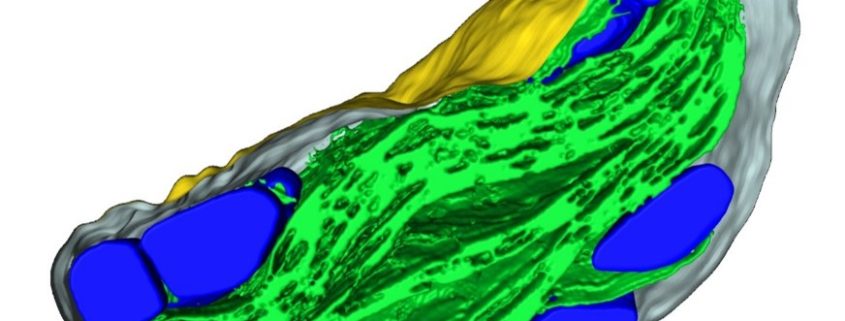Plant Science Research Weekly: February 2, 2024
Review: A century of studying plant secondary metabolism—From “what?” to “where, how, and why?”
 Phytochemicals, also known as plant secondary metabolites, play primary roles in plant development, structure, and response to the environment. Their metabolism has been studied for over a century. In a new review, Dixon and Dickinson discuss past and recent advances in understanding the identity, localization, biosynthesis, and functions of phytochemicals over the past century. One of the topics of this review is the importance of plant secondary metabolites in human medicine and agricultural biotechnology, and their other potential benefits for society. The authors also highlight how secondary metabolites are used by plants in defense, development and chemical ecology. Another theme in the review is the techniques used over the years in discovery and analysis of secondary metabolites, from classic chemistry to high-throughput gene sequencing, mass spectrometry, AI, and synthetic biology. Other newly emerging technologies, such as single-cell omics and small-molecule biosensors are also discussed, as are areas needing further exploration. (Summary by Idowu Arinola Obisesan @IdowuAobisesan) Plant Physiol. 10.1093/plphys/kiad596
Phytochemicals, also known as plant secondary metabolites, play primary roles in plant development, structure, and response to the environment. Their metabolism has been studied for over a century. In a new review, Dixon and Dickinson discuss past and recent advances in understanding the identity, localization, biosynthesis, and functions of phytochemicals over the past century. One of the topics of this review is the importance of plant secondary metabolites in human medicine and agricultural biotechnology, and their other potential benefits for society. The authors also highlight how secondary metabolites are used by plants in defense, development and chemical ecology. Another theme in the review is the techniques used over the years in discovery and analysis of secondary metabolites, from classic chemistry to high-throughput gene sequencing, mass spectrometry, AI, and synthetic biology. Other newly emerging technologies, such as single-cell omics and small-molecule biosensors are also discussed, as are areas needing further exploration. (Summary by Idowu Arinola Obisesan @IdowuAobisesan) Plant Physiol. 10.1093/plphys/kiad596
Review: Autophagy: A key player in the recovery of plants from heat stress
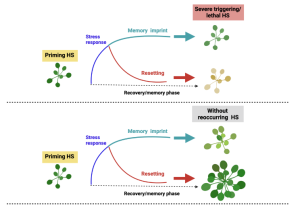 Plants have a remarkable ability to adapt to stress. For many stresses, plants respond to short-term mild exposure by becoming more tolerant to subsequent harsher stresses that would otherwise be lethal; this effect is known as priming. Priming occurs through several mechanisms that can include changes to metabolism, accumulation of transcription factors or miRNAs, and epigenetic changes to chromatin. What is less well understood is how plants reset, which is the topic of this review by Sedaghatmehr and Balazadeh. Although the state of being primed can prevent death, it is often accompanied by a reduced growth rate. Therefore, at some point the plant needs to reset to pre-primed state, a process that involves autophagy. Autophagy is a complex set of pathways that lead to the degradation of cytoplasmic constituents and organelles, and so has been widely studied during senescence or periods of starvation. Autophagy is also induced following heat stress and during recovery; furthermore, autophagy mutants show decreased thermotolerance. As global temperatures continue to rise, a better understanding of how plants tolerate and recover from heat stress is needed. (Summary by Mary Williams @PlantTeaching) J. Exp. Bot 10.1093/jxb/erae018
Plants have a remarkable ability to adapt to stress. For many stresses, plants respond to short-term mild exposure by becoming more tolerant to subsequent harsher stresses that would otherwise be lethal; this effect is known as priming. Priming occurs through several mechanisms that can include changes to metabolism, accumulation of transcription factors or miRNAs, and epigenetic changes to chromatin. What is less well understood is how plants reset, which is the topic of this review by Sedaghatmehr and Balazadeh. Although the state of being primed can prevent death, it is often accompanied by a reduced growth rate. Therefore, at some point the plant needs to reset to pre-primed state, a process that involves autophagy. Autophagy is a complex set of pathways that lead to the degradation of cytoplasmic constituents and organelles, and so has been widely studied during senescence or periods of starvation. Autophagy is also induced following heat stress and during recovery; furthermore, autophagy mutants show decreased thermotolerance. As global temperatures continue to rise, a better understanding of how plants tolerate and recover from heat stress is needed. (Summary by Mary Williams @PlantTeaching) J. Exp. Bot 10.1093/jxb/erae018
UMAMIT44 exports plastidial glutamate and is essential for plant growth
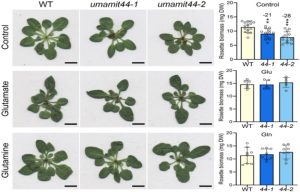 Amino acids (AA) are fundamental components of peptides, proteins, and enzymes that play a critical role in plant growth, cellular metabolism, and stress response. Plants synthesize most AA within chloroplasts and require membrane transporters to transfer them from stroma to cytosol. Cytosolic AA are essential for synthesizing proteins and provide nitrogen support for the growth of sink organs, such as seeds. However, there are unknown players in plant chloroplasts involved in AA export. In new work by The et al., USUALLY MULTIPLE ACIDS MOVE IN AND OUT TRANSPORTER 44 (UMAMIT44) in Arabidopsis thaliana was discovered and shown to function as an AA exporter from chloroplasts. UMAMIT44 was identified as a candidate for plastidial export based on localization prediction tools and microscopy imaging, which showed that UMAMIT44 is localized in plastids throughout the plant but more abundant in green tissues. Physiological, biochemical, and molecular analyses of umamit44 mutants confirmed that it regulates glutamate export from plastids and maintains glutamate homeostasis within and outside chloroplasts. It was also seen to alter the source-to-sink transport of nitrogen, cellular redox state, and carbon metabolites, leading to adverse effects on plant growth and development. Overall, this study established UMAMIT44 as a key player in glutamate export from chloroplasts. (Summary by Maneesh Lingwan @LingwanManeesh) Plant Cell 10.1093/plcell/koad310
Amino acids (AA) are fundamental components of peptides, proteins, and enzymes that play a critical role in plant growth, cellular metabolism, and stress response. Plants synthesize most AA within chloroplasts and require membrane transporters to transfer them from stroma to cytosol. Cytosolic AA are essential for synthesizing proteins and provide nitrogen support for the growth of sink organs, such as seeds. However, there are unknown players in plant chloroplasts involved in AA export. In new work by The et al., USUALLY MULTIPLE ACIDS MOVE IN AND OUT TRANSPORTER 44 (UMAMIT44) in Arabidopsis thaliana was discovered and shown to function as an AA exporter from chloroplasts. UMAMIT44 was identified as a candidate for plastidial export based on localization prediction tools and microscopy imaging, which showed that UMAMIT44 is localized in plastids throughout the plant but more abundant in green tissues. Physiological, biochemical, and molecular analyses of umamit44 mutants confirmed that it regulates glutamate export from plastids and maintains glutamate homeostasis within and outside chloroplasts. It was also seen to alter the source-to-sink transport of nitrogen, cellular redox state, and carbon metabolites, leading to adverse effects on plant growth and development. Overall, this study established UMAMIT44 as a key player in glutamate export from chloroplasts. (Summary by Maneesh Lingwan @LingwanManeesh) Plant Cell 10.1093/plcell/koad310
Altering the location of starch granules by relocalizing a starch granule initiation protein
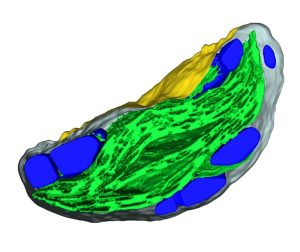 Starch granules are synthesized in leaf chloroplasts during the day and degraded at night to provide carbon. MFP1 (MAR-BINDING FILAMENT-LIKE PROTEIN 1) is known to have a role in starch granule initiation, but its mechanistic role has been unknown. Sharma et al. hypothesized MFP1’s thylakoid localization signals are important for its role; to test this they swapped the transit peptide, thylakoid signal peptide, and transmembrane domains from MFP1 for the N-terminal region of the chloroplast inner envelope protein Tic40 (TRANSLOCON AT THE INNER ENVELOPE MEMBRANE OF CHLOROPLASTS 40); they call this new protein Tic40NMFP1. When Tic40NMFP1 is expressed under a ubiquitin promoter in mfp1 Arabidopsis plants, MFP1 was not found at the thylakoid membranes but instead localized to the chloroplast periphery. Interestingly, they saw relocalization of other key starch granule initiation proteins, including SS4 (STARCH SYTHASE 4) and PTST2 (PROTEIN TARGETING TO STARCH 2), to the same location. Analysis of chloroplast ultrastructure by focused ion beam-scanning electron microscopy revealed that starch granules were also forming at the periphery of the chloroplast, rather than near the thylakoids, and these were smaller and rounder than those in wild type plants. Hence MFP1 is important for localizing granule initiation proteins and ensuring starch granules form near thylakoid membranes. (Summary by Rose McNelly @Rose_McN) Proc. Natl. Acad. Sci. USA 10.1073/pnas.2309666121
Starch granules are synthesized in leaf chloroplasts during the day and degraded at night to provide carbon. MFP1 (MAR-BINDING FILAMENT-LIKE PROTEIN 1) is known to have a role in starch granule initiation, but its mechanistic role has been unknown. Sharma et al. hypothesized MFP1’s thylakoid localization signals are important for its role; to test this they swapped the transit peptide, thylakoid signal peptide, and transmembrane domains from MFP1 for the N-terminal region of the chloroplast inner envelope protein Tic40 (TRANSLOCON AT THE INNER ENVELOPE MEMBRANE OF CHLOROPLASTS 40); they call this new protein Tic40NMFP1. When Tic40NMFP1 is expressed under a ubiquitin promoter in mfp1 Arabidopsis plants, MFP1 was not found at the thylakoid membranes but instead localized to the chloroplast periphery. Interestingly, they saw relocalization of other key starch granule initiation proteins, including SS4 (STARCH SYTHASE 4) and PTST2 (PROTEIN TARGETING TO STARCH 2), to the same location. Analysis of chloroplast ultrastructure by focused ion beam-scanning electron microscopy revealed that starch granules were also forming at the periphery of the chloroplast, rather than near the thylakoids, and these were smaller and rounder than those in wild type plants. Hence MFP1 is important for localizing granule initiation proteins and ensuring starch granules form near thylakoid membranes. (Summary by Rose McNelly @Rose_McN) Proc. Natl. Acad. Sci. USA 10.1073/pnas.2309666121
In tune with power: Mitochondrial regulation of energy with TOR
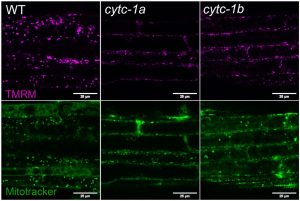 As seedlings grow, they continuously fine-tune the balance between plant growth and energy consumption for better plant fitness. Mitochondria are essential to generate energy. Here, Canal et al. generated single mutants for a gene involved in the mitochondrial respiratory chain – CYTOCHROME C-1 (CYTC-1), which caused defective mitochondrial energy production, membrane potential, lower ATP content, and a reduced growth rate in the cytc-1 mutants. Some of the mutant phenotypes resemble those of plants with abnormal Target of Rapamycin (TOR) signaling. TOR is a protein that integrates growth-related processes in all eukaryotes. The authors showed that TOR activity is impaired in the cytc-1 mutants. In contrast, TOR overexpression rescued the seedling growth and low ATP level of cytc-1 mutant. The authors conclude that plants can coordinate their metabolism in response to the disruption of the mitochondrial function in the cytc-1 mutation, which anticipates energy exhaustion and speculates that conditions by reducing TOR activity levels and slowing growth. This study also sheds light on how mitochondria communicate their status to the rest of the cell. (Summary by Yueh Cho @YuehCho1984) New Phytol. 10.1111/nph.19506.
As seedlings grow, they continuously fine-tune the balance between plant growth and energy consumption for better plant fitness. Mitochondria are essential to generate energy. Here, Canal et al. generated single mutants for a gene involved in the mitochondrial respiratory chain – CYTOCHROME C-1 (CYTC-1), which caused defective mitochondrial energy production, membrane potential, lower ATP content, and a reduced growth rate in the cytc-1 mutants. Some of the mutant phenotypes resemble those of plants with abnormal Target of Rapamycin (TOR) signaling. TOR is a protein that integrates growth-related processes in all eukaryotes. The authors showed that TOR activity is impaired in the cytc-1 mutants. In contrast, TOR overexpression rescued the seedling growth and low ATP level of cytc-1 mutant. The authors conclude that plants can coordinate their metabolism in response to the disruption of the mitochondrial function in the cytc-1 mutation, which anticipates energy exhaustion and speculates that conditions by reducing TOR activity levels and slowing growth. This study also sheds light on how mitochondria communicate their status to the rest of the cell. (Summary by Yueh Cho @YuehCho1984) New Phytol. 10.1111/nph.19506.
Unveiling distinct responses of maize primary and seminal roots under drought stress
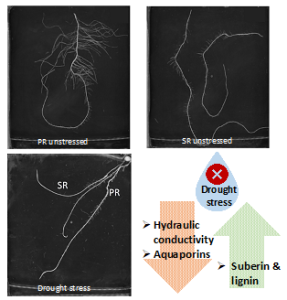 Can you imagine going a day without a sip of water? Neither can plants. Water is essential for supporting diverse physiological processes in plants, including photosynthesis, nutrient transport, temperature regulation, and maintenance of cell turgidity. However, with global increase in temperature and shift in weather patterns, droughts have become increasingly frequent and prolonged that severely impact plant growth and productivity. Plants modulate their root system architecture to sustain their water acquisition capacity under drought stress. In this study, Protto et al. investigated the growth pattern and hydraulic response of maize roots subjected to drought stress. Although growth inhibition and reduction in hydraulic conductivity was observed in both primary roots (PR) and seminal roots (SR) under stress conditions, SR were more sensitive to drought stress than PR. Moreover, relative abundance of aquaporins, involved in water transport across cell membranes, declined more in PR than SR under water deficit. Drought stress can also alter suberin and lignin deposition in the root layers, therefore, the authors examined the root anatomy. Suberin and lignin deposition was increased in PR endodermis but not in SR during water deficit. These findings clearly demonstrate distinct anatomical and hydraulic responses among various root types in maize. The unique functional characteristics and developmental plasticity of the maize root system may improve plant resilience in the face of drought stress. (Summary by Abira Sahu @AbiraSahu) Plant Physiol. 10.1093/plphys/kiad675
Can you imagine going a day without a sip of water? Neither can plants. Water is essential for supporting diverse physiological processes in plants, including photosynthesis, nutrient transport, temperature regulation, and maintenance of cell turgidity. However, with global increase in temperature and shift in weather patterns, droughts have become increasingly frequent and prolonged that severely impact plant growth and productivity. Plants modulate their root system architecture to sustain their water acquisition capacity under drought stress. In this study, Protto et al. investigated the growth pattern and hydraulic response of maize roots subjected to drought stress. Although growth inhibition and reduction in hydraulic conductivity was observed in both primary roots (PR) and seminal roots (SR) under stress conditions, SR were more sensitive to drought stress than PR. Moreover, relative abundance of aquaporins, involved in water transport across cell membranes, declined more in PR than SR under water deficit. Drought stress can also alter suberin and lignin deposition in the root layers, therefore, the authors examined the root anatomy. Suberin and lignin deposition was increased in PR endodermis but not in SR during water deficit. These findings clearly demonstrate distinct anatomical and hydraulic responses among various root types in maize. The unique functional characteristics and developmental plasticity of the maize root system may improve plant resilience in the face of drought stress. (Summary by Abira Sahu @AbiraSahu) Plant Physiol. 10.1093/plphys/kiad675
Auxin receptor OsTIR1 mediates auxin signaling during seed filling in rice
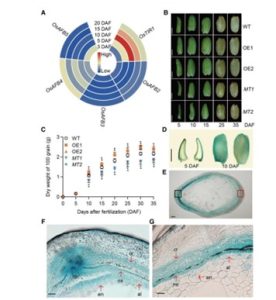 Throughout the world, cereal endosperm is a major source of food. However, little is known about the molecular mechanisms underlying the import of sugar into the endosperm of rice plants (Oryza sativa) and how these pathways relate to auxin signaling. In this paper, Wu et al. investigate the role of auxin receptor OsTIR1 (Oryza sativa transport inhibitor response 1) in rice seed filling and its relationship with sugar import into the endosperm. The authors found that OsTIR1 mediates sugar import into endosperm via the auxin signaling component OsARF25 interacting with the sugar transporter OsSWEET11. Mutations in OsTIR1 repressed starch accumulation and reduced grain yield and quality, while overexpression of the gene improved starch accumulation and grain yield and quality. OsTIR1 has been shown to be highly expressed in the endosperm, nucellar projection, nucellar epidermis, aleurone layer cells, and ovular vascular trace, suggesting a possible route for sugar to enter the endosperm. The main auxin signaling element implicated in rice grain filling is known to be OsAR25, which interacts with the sugar transporter OsSWEET11. It has been hypothesized that OsIAA1 interacts directly with OsARF25 to influence OsTIR1-regulated endosperm development. Compared to wild-type plants, the overexpression of OsTIR1 improved grain quality and boosted grain output by 32% to 52% over the course of three years of field trials. Additionally, the authors observed that lower grain size and grain yield in tir1 mutant lines might also result from slender stems and less adventitious roots in tir1 mutant lines relative to wild-type plants. (Summary by Muhammad Aamir Khan @MAKNature1998) Plant Physiol. 10.1093/plphys/kiae013
Throughout the world, cereal endosperm is a major source of food. However, little is known about the molecular mechanisms underlying the import of sugar into the endosperm of rice plants (Oryza sativa) and how these pathways relate to auxin signaling. In this paper, Wu et al. investigate the role of auxin receptor OsTIR1 (Oryza sativa transport inhibitor response 1) in rice seed filling and its relationship with sugar import into the endosperm. The authors found that OsTIR1 mediates sugar import into endosperm via the auxin signaling component OsARF25 interacting with the sugar transporter OsSWEET11. Mutations in OsTIR1 repressed starch accumulation and reduced grain yield and quality, while overexpression of the gene improved starch accumulation and grain yield and quality. OsTIR1 has been shown to be highly expressed in the endosperm, nucellar projection, nucellar epidermis, aleurone layer cells, and ovular vascular trace, suggesting a possible route for sugar to enter the endosperm. The main auxin signaling element implicated in rice grain filling is known to be OsAR25, which interacts with the sugar transporter OsSWEET11. It has been hypothesized that OsIAA1 interacts directly with OsARF25 to influence OsTIR1-regulated endosperm development. Compared to wild-type plants, the overexpression of OsTIR1 improved grain quality and boosted grain output by 32% to 52% over the course of three years of field trials. Additionally, the authors observed that lower grain size and grain yield in tir1 mutant lines might also result from slender stems and less adventitious roots in tir1 mutant lines relative to wild-type plants. (Summary by Muhammad Aamir Khan @MAKNature1998) Plant Physiol. 10.1093/plphys/kiae013
Receptor-associated kinases control lipid provisioning in plant–fungal symbiosis
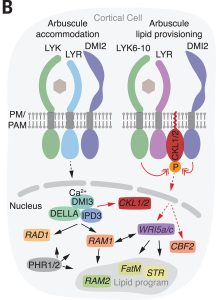 Most plants benefit from symbiotic associations with fungi, in which the fungi aid in nutrient update particularly of phosphate, and the plant returns the favor by supplying the fungi with lipids. Several but not all of the molecular players required for these important pathways have been identified. Here Ivanov and Harrison have uncovered additional components, the membrane-bound CYCLIN-DEPENDENT KINASE-LIKE proteins CKL1 and CKL2. The genes encoding CKL1 and 2 are upregulated in fungal-colonized Medicago truncatula roots. CRISPR/Cas9 mutations show that the genes are required for successful colonization and arbuscule establishment. Expression of these genes activates downstream pathways required for production of the lipid reward, and this activity depends on CKL1 and 2 kinase activity, membrane-localization, and interaction with the leucine-rich repeat receptor-like kinase DMI2 and a subset of LysM receptor kinases. (Summary by Mary Williams @PlantTeaching) Science 10.1126/science.ade1124
Most plants benefit from symbiotic associations with fungi, in which the fungi aid in nutrient update particularly of phosphate, and the plant returns the favor by supplying the fungi with lipids. Several but not all of the molecular players required for these important pathways have been identified. Here Ivanov and Harrison have uncovered additional components, the membrane-bound CYCLIN-DEPENDENT KINASE-LIKE proteins CKL1 and CKL2. The genes encoding CKL1 and 2 are upregulated in fungal-colonized Medicago truncatula roots. CRISPR/Cas9 mutations show that the genes are required for successful colonization and arbuscule establishment. Expression of these genes activates downstream pathways required for production of the lipid reward, and this activity depends on CKL1 and 2 kinase activity, membrane-localization, and interaction with the leucine-rich repeat receptor-like kinase DMI2 and a subset of LysM receptor kinases. (Summary by Mary Williams @PlantTeaching) Science 10.1126/science.ade1124
Convergent evolution in pitcher plant traps reveals a mechanism for composite trait evolution
It’s easy for most of us to grasp how an enzyme evolves new functions or substrate specificities, but envisioning how something incredibly complex like the human eye can be quite challenging (even Darwin was stumped). In this fascinating paper, Chomicki et al. asked how two geographically separated carnivorous pitcher plants evolved the same complex trap mechanism, which in part addresses this conundrum. Specifically, they looked at Nepenthes gracilis and Nepenthes pervillei, both of which use a springboard mechanism to trap insects. The trap requires three components, each useless without the other two: a horizontal lid that hovers above the pitcher, a slippery but not too-slippery surface on the underside of the lid, and a hinge on the lid that, when hit by rain, shakes the insects into the trap (see video). A phylogenetic analysis ruled out a single evolutionary origin for the trap mechanism, indicating that they are the product of convergent evolution. The three traits show independent evolution, indicating that the complex trait is a result of “spontaneous coincidence” in which the chance occurrence of the three traits provides a selective advantage that becomes fixed. This article is accompanied by another example of complex trait evolution (in snails) and a related perspective. (Summary by Mary Williams @PlantTeaching) Science 10.1126/science.ade0529. (Perspective article 10.1126/science.adm9239).
The global distribution of plant diversity and its significance to humans
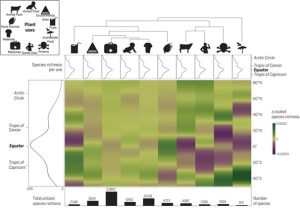 Plants shape ecosystems and sustain human life. Only a small portion of plant diversity is currently known to be in use, even though most plants may be useful to humans. Over time, certain species become widespread, but others are native to specific geographical regions. Thus, to manage plant resources efficiently and sustainably, people must understand the regional patterns of species variation. Pironon et al. followed Economic Botany Data Collection Standards to examine how 35,687 plant species are used worldwide for ten categories (food, materials, fuels, medicines, and others). All categories showed similar latitudinal variation in used plant species richness, representing greater values in the tropics but diminishing toward high latitudes. However, there are notable differences between temperate and tropical regions. Temperate environments contain more vertebrate food, social, and poisonous plant species. Tropical habitats have more species related to food, materials, and medicine. Human-used plants are more diverse in Mesoamerica, the Horn of Africa, and Southern Asia, but fewer protected areas in these locations reduce the biodiversity of exploited species. The relationship between species diversity and plant variety suggests safeguarding biodiversity hotspots protects these species. Multiple species and their genetic diversity are underrepresented in seed banks and botanical gardens. Therefore, it is crucial to identify and understand the diversity and geographic spread of plant species used by people to implement conservation policies and develop plant-derived solutions to global concerns like hunger, diseases, and climate change. (Summary by Maneesh Lingwan @LingwanManeesh) Science 10.1126/science.adg8028
Plants shape ecosystems and sustain human life. Only a small portion of plant diversity is currently known to be in use, even though most plants may be useful to humans. Over time, certain species become widespread, but others are native to specific geographical regions. Thus, to manage plant resources efficiently and sustainably, people must understand the regional patterns of species variation. Pironon et al. followed Economic Botany Data Collection Standards to examine how 35,687 plant species are used worldwide for ten categories (food, materials, fuels, medicines, and others). All categories showed similar latitudinal variation in used plant species richness, representing greater values in the tropics but diminishing toward high latitudes. However, there are notable differences between temperate and tropical regions. Temperate environments contain more vertebrate food, social, and poisonous plant species. Tropical habitats have more species related to food, materials, and medicine. Human-used plants are more diverse in Mesoamerica, the Horn of Africa, and Southern Asia, but fewer protected areas in these locations reduce the biodiversity of exploited species. The relationship between species diversity and plant variety suggests safeguarding biodiversity hotspots protects these species. Multiple species and their genetic diversity are underrepresented in seed banks and botanical gardens. Therefore, it is crucial to identify and understand the diversity and geographic spread of plant species used by people to implement conservation policies and develop plant-derived solutions to global concerns like hunger, diseases, and climate change. (Summary by Maneesh Lingwan @LingwanManeesh) Science 10.1126/science.adg8028


